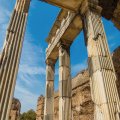A remarkable imperial villa near Tivoli, a splendid testimony to the grandeur and splendor of Rome.
Here is the richest and the largest of the imperial villas. Situated 6 km from Tivoli, the villa of the emperor Hadrian was built in the first half of the first century A.D.: he himself supervised the works. Hadrian wanted to reproduce the places and buildings that had struck him the most during his travels throughout the Empire: the Lyceum, the Academy, the Prytaneum, the Paecile of Athens, the canal of Canope on the Nile delta, the Valley of Time in Thessaly, and the Underworld described by the poets. A pleasure residence, the term "villa" applies here to a real small city, with the emperor's palace, that of his entourage, the barracks for the soldiers and the thermal baths (indispensable at the time); without forgetting the leisure activities, with the theater and the spaces reserved for sports like the swimming pool and the gymnasium. Lush gardens dotted with sculptures, grottoes and water basins surround the buildings. The ensemble openly refers to classical Greece and Hellenistic Egypt, according to the wishes of its creator. Hadrian's villa reflects the refined culture of this emperor, who thought of ending his days there. In spite of the various destructions suffered through the centuries (during the barbarian invasions, but also during the Middle Ages, when the site was only a vast quarry), the villa remains a splendid testimony of the greatness and splendor of Rome.
Pœcile. The visit can begin with the pœcile, a rectangular portico that encloses a garden with a central fishpond. It is a reproduction of the portico of Athens, called for its paintings the "multicolored portico".
Maritime Theater. Through the library, we arrive at the Maritime Theater, a circular building with a portico, surrounded by a ring-shaped canal where an islet rises. This place was probably a kind of refuge where the emperor could quietly go about his favorite activities. To the south of the Maritime Theater, we reach theheliocaminus, an area apparently used for sunbathing. Further on, there are the large thermal baths, arranged according to the traditional structure of the Roman baths.
Canope. From the big baths, we reach the canope, one of the most original monuments of the whole archaeological complex of Hadrian's villa. It is a small artificial valley, narrow and 195 m long, inspired by the Egyptian city of Canope, near Alexandria, where, according to the accounts of Strabo, stood a temple of Serapis, then very venerated. The pilgrims flocked there by descending a canal derived from an arm of the Nile. Hadrian wanted to rebuild in his villa this place of worship and relaxation. The canal ended with the great water play of the Serapeum, a temple with a semicircular exedra, surrounded by Egyptian statues and representations of Antinous, the emperor's favorite.
Other monuments. Among the other important monuments, it is still necessary to quote the imposing set of the imperial Palace and the place of Gold. The latter was used as a triclinium in the summer and takes its name from the richness of the decorations and pieces that have been discovered there. The large inner courtyard was surrounded by a portico with six columns; in the center was a garden with a pool.
Underground. A real network of underground passages has survived until our time; a functional solution wanted by the emperor in order to be able to move in all discretion without being seen on the surface.
Did you know? This review was written by our professional authors.
Book the Best Activities with Get Your Guide
Members' reviews on VILLA ADRIANA
The ratings and reviews below reflect the subjective opinions of members and not the opinion of The Little Witty.
pure il bar.... solito spreco italiano. si potrebbe migliorare molto con tecnologie moderne, realtà aumentata ecc... invece stanno ancora coi tornelli.... imbarazzo.
Solo una cosa, dispiacere è da pagare per parcheggio, si paga 12euro, spazio c'è, andrebbe anche bene di gratis per parcheggio...????
Find unique Stay Offers with our Partners







Il biglietto è di 12 euro. Per visitare bene la villa ci vogliono circa 1 ora e mezza o due.
Consiglio la VISITA GUIDATA. Per me è stata fondamentale per capire i resti archeologici. Costa 7 euro in più ma ne va la pena. Tra l’altro la guida Laura è stata bravissima! Riesci a dividere le zone pubbliche e private della villa, a capire le funzioni, a conoscere le terme e le destinazioni.